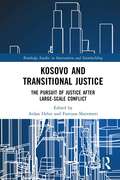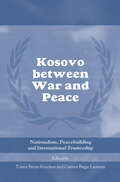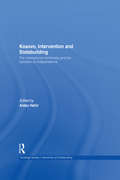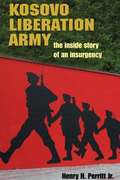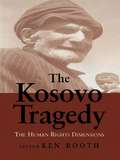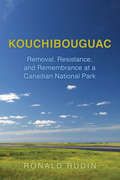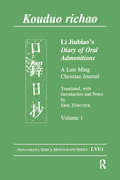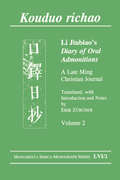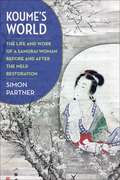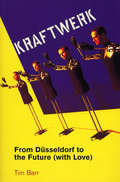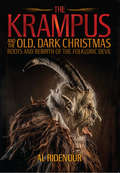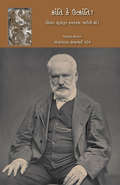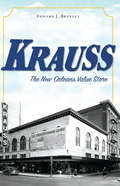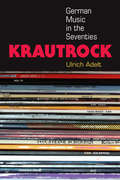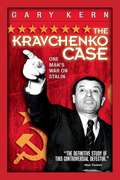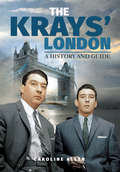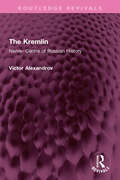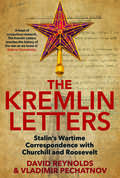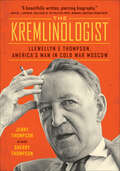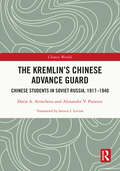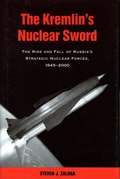- Table View
- List View
Kosovo and Transitional Justice: The Pursuit of Justice After Large Scale-Conflict (Routledge Studies in Intervention and Statebuilding)
by Aidan HehirThis book analyses efforts to achieve justice in Kosovo for victims of crimes committed during the conflict in the 1990s, relating this to broader debates on transitional justice. The war in Kosovo has come under the jurisdiction of a number of mechanisms which fit within the broader framework of transitional justice. These include international tribunals (the ICTY), international organisations with judicial mandates within Kosovo (UNMIK and EULEX), ad-hoc hybrid tribunals (the Kosovo Specialist Chambers) and truth-seeking mechanisms (RECOM and the Truth and Reconciliation Commission). Collectively, these developments make Kosovo a profoundly important case study on the contemporary efficacy of transitional justice. This volume analyses the nature and impact of the various mechanisms employed to date in Kosovo to determine their effects within the country, and their broader international significance. Various critical issues are examined through an exploration of the institutional mechanisms employed in each case, their coherence with existing theories on "best practice" principles, and the broader implications of their efficacy in Kosovo. This book will be of much interest to students of transitional justice, statebuilding, Balkan politics, and International Relations in general.
Kosovo between War and Peace: Nationalism, Peacebuilding and International Trusteeship (Cass Series on Peacekeeping)
by Carsten Bagge Laustsen Tonny Brems KnudsenA major contribution to the debate about the reconstruction of Kosovo, and to the general discussion surrounding the revived 'trusteeship institution' model in the context of the UN internationalism of the 1990s and the War on Terror following 9/11. Bringing together leading international scholars, this book presents the latest empirical research alongside detailed theoretical analysis. Examining the key questions local parties and the international community have encountered in Kosovo, including how to develop effective and inclusive local government, how to counter crime and the dysfunctional aspects of liberal economic reform, how to unite the partly opposed goals of reconstructing the province while avoiding renewed ethnic and international strife, and how to handle the specific challenge of Kosovo’s future status. The contributors also re-examine the background factors that continue to influence and hamper the attempt to administrate and reconstruct the province, first of all the nationalist ideologies and the record of ethnic violence. This book will be of great interest to all students of Balkan politics, peacekeeping, international relations and security studies in general.
Kosovo, Intervention and Statebuilding: The International Community and the Transition to Independence (Routledge Studies in Intervention and Statebuilding)
by Aidan HehirThis book examines international engagement with Kosovo since NATO's intervention in 1999, and looks at the three distinct phases of Kosovo's development; intervention, statebuilding and independence. Kosovo remains a case study of central importance in international relations, illustrative of key political trends in the post-Cold War era. During each phase, international policy towards Kosovo has challenged prevailing international norms and pushed the boundaries of conventional wisdom. In each of the three phases 'Kosovo' has been cited as constituting a precedent, and this book explores the impact and the often troubling consequences and implications of these precedents. This book explicitly engages with this debate, which transcends Kosovo itself, and provides a critical analysis of the catalysts and consequences of contemporary international engagement with this seminal case study. Each chapter focuses on a particular aspect of the international engagement with Kosovo and situates events there in an international context, highlighting the extent to which international policy towards Kosovo has challenged existing norms and practices. Kosovo has been cited in certain texts as a positive template to be emulated, but the contributors to this book also identify the often controversial and contentious nature of these new norms. This book will be of much interest to students of humanitarian intervention and statebuilding, war and conflict studies, security studies and IR in general. Aidan Hehir is a Senior Lecturer in International Relations at the Department of Politics and International Relations, University of Westminster.
Kosovo Liberation Army: The Inside Story of an Insurgency
by Henry H. PerrittThe military intervention by NATO in Kosovo was portrayed in American media as a necessary step to prevent the Serbian armed forces from repeating the ethnic cleansing that had so deeply damaged the former Yugoslavia. Serbia trained its military on Kosovo because of an ongoing armed struggle by ethnic Albanians to wrest independence from Serbia. Warfare in the Balkans seemed to threaten the stability of Europe, as well as the peace and security of Kosovars, and yet armed resistance seemed to offer the only possibility of future stability. Leading the struggle against Serbia was the Kosovo Liberation Army, also known as the KLA. Kosovo Liberation Army: The Inside Story of an Insurgency provides a historical background for the KLA and describes its activities up to and including the NATO intervention. Henry H. Perritt Jr. offers firsthand insight into the motives and organization of a popular insurgency, detailing the strategies of recruitment, training, and financing that made the KLA one of the most successful insurgencies of the post-cold war era. This volume also tells the personal stories of young people who took up guns in response to repeated humiliation by "foreign occupiers," as they perceived the Serb police and intelligence personnel. Perritt illuminates the factors that led to the KLA's success, including its convergence with political developments in eastern Europe, its campaign for popular support both at home and abroad, and its participation in international negotiations and a peace settlement that helped pave the long road from war to peace.
The Kosovo Tragedy: The Human Rights Dimensions
by Ken BoothThe 1999 conflict in Kosovo is seen as being as significant for international affairs as the pulling down of the Berlin Wall, because of the centrality of human rights in the build-up, conduct and aftermath of the war. This volume is an attempt to explore this human rights tragedy.
Kouchibouguac: Removal, Resistance, and Remembrance at a Canadian National Park
by Ronald RudinIn 1969, the federal and New Brunswick governments created Kouchibouguac National Park on the province's east coast. The park's creation required the relocation of more than 1200 people who lived within its boundaries. Government officials claimed the mass eviction was necessary both to allow visitors to view "nature" without the intrusion of a human presence and to improve the lives of the former inhabitants. But unprecedented resistance by the mostly Acadian residents, many of whom described their expulsion from the park as a "second deportation," led Parks Canada to end its practice of forcible removal. One resister, Jackie Vautour, remains a squatter on his land to this day.In Kouchibouguac, Ronald Rudin draws on extensive archival research, interviews with more than thirty of the displaced families, and a wide range of Acadian cultural creations to tell the story of the park's establishment, the resistance of its residents, and the memory of that experience.
Kouduo richao. Li Jiubiao's Diary of Oral Admonitions. A Late Ming Christian Journal: Translated, with Introduction and Notes by Erik Z�rcher, Vol. 1
by Erik ZürcherThe Diary of Oral Admonitions (Kouduo richao) is an invaluable mirror of early Chinese Christianity, as it stands out as the only source that allows a glimpse of Jesuit missionary practice in China on a local level - "accommodation in action" - and of the various responses of the Chinese audience, both converts and interested outsiders. It is a compilation of some five hundred notes "about everything" made by Li Jiubiao and other Christian literati during their conversations with Jesuit missionaries in Fujian between 1630 and 1640. These notes are arranged in chronological order and divided into eight books. The most important Western protagonist in the Diary is the Italian Jesuit Giulio Aleni (1589-1642), called "Master Ai (Rulüe)" in Chinese. The present study and translation of the Diary of Oral Admonitions can be seen as a companion volume to the proceedings of an international conference that was held on Aleni in his native place Brescia in 1994, also published in the Monumenta Serica Monograph Series XLII: "Scholar from the West." Giulio Aleni S.J. (1582-1649) and the Dialogue between China and Christianity, 1997. The present work in two volumes is meant to be a tool for further research. Volume 1 presents a comprehensive introduction to the Diary and its historical context, followed by the annotated translation, both by Erik Zürcher (Leiden), a renown specialist for the study of Christianity in China. It is enhanced by illustrations, partly in colour, and maps. Volume 2 includes a facsimile of the Chinese text (reproducing a copy held in the Roman Archives of the Society of Jesus), a bibliography of Chinese and Western sources as well as secondary literature, and an analytical index with glossary that will enable the reader to trace specific data in the text.
Kouduo richao. Li Jiubiao's Diary of Oral Admonitions. A Late Ming Christian Journal: Translated, with Introduction and Notes by Erik Zurcher, Vol. 2
by Erik ZürcherThe Diary of Oral Admonitions (Kouduo richao) is an invaluable mirror of early Chinese Christianity, as it stands out as the only source that allows a glimpse of Jesuit missionary practice in China on a local level - "accommodation in action" - and of the various responses of the Chinese audience, both converts and interested outsiders. It is a compilation of some five hundred notes "about everything" made by Li Jiubiao and other Christian literati during their conversations with Jesuit missionaries in Fujian between 1630 and 1640. These notes are arranged in chronological order and divided into eight books. The most important Western protagonist in the Diary is the Italian Jesuit Giulio Aleni (1589-1642), called "Master Ai (Rulüe)" in Chinese. The present study and translation of the Diary of Oral Admonitions can be seen as a companion volume to the proceedings of an international conference that was held on Aleni in his native place Brescia in 1994, also published in the Monumenta Serica Monograph Series XLII: "Scholar from the West." Giulio Aleni S.J. (1582-1649) and the Dialogue between China and Christianity, 1997. The present work in two volumes is meant to be a tool for further research. Volume 1 presents a comprehensive introduction to the Diary and its historical context, followed by the annotated translation, both by Erik Zürcher (Leiden), a renown specialist for the study of Christianity in China. It is enhanced by illustrations, partly in colour, and maps. Volume 2 includes a facsimile of the Chinese text (reproducing a copy held in the Roman Archives of the Society of Jesus), a bibliography of Chinese and Western sources as well as secondary literature, and an analytical index with glossary that will enable the reader to trace specific data in the text.
Koume’s World: The Life and Work of a Samurai Woman Before and After the Meiji Restoration
by Simon PartnerKawai Koume (1804–1889) was an accomplished poet and painter and a wife, mother, and grandmother in a lower-ranking samurai family in the provincial castle town of Wakayama. She was an eyewitness to many of the key events leading up to the Meiji Restoration and the radical changes that followed, including the famine of 1837, the great earthquake of 1854, the cholera epidemic of 1859, and the departure of samurai to fight in the civil wars of the 1860s. For more than fifty years, she kept a diary recording her family’s daily life—meals and expenses, visitors and the weather, small-town gossip and news of momentous events.Through Koume’s eyes and words, Simon Partner opens a window on social, economic, and cultural life amid some of the most dramatic periods of Japan’s transformative nineteenth century. Koume’s World vividly portrays the everyday activities, social interactions, information networks, cultural production, and household economy of a samurai family across the Tokugawa-Meiji divide. Partner’s narrative offers a remarkably detailed portrait of the dynamic working life of a female artist and household manager while also giving a regional perspective on the upheavals surrounding the Meiji Restoration. A compelling microhistorical study of gender, economy, and society in nineteenth-century Japan, Koume’s World is a compelling account of how one woman experienced both mundane routines and drastic social transformations.
Kraftwerk: from Dusseldorf to the Future With Love
by Tim BarrThe future of modern music began in Dusseldorf in 1970, when an avant-garde German band, the Organisation re-invented themselves as Kraftwerk and set in motion a train of events which introduced a whole new language into popular culture. By pre-dating electro, house, ambient and techno by more than two decades, they are quite simply the most influentual band of the late 20th century. Having studied composi-tional theory at the Dusseldorf Conservatory, they have more in common with Stockhausen and Russian Constructivism than Chuck Berry and Andy Warhol and yet, in creating classic pop hits like 'Autobahn', 'Trans Europe Express', 'The Model' and 'Tour de France' Kraftwork created a mass-market blueprint. The list of those directly and profoundly influenced is staggering: Bowie & Iggy Pop; Human League; disco (Giorgio Moroder`s seminal work with Donna Summer); Gary Numan: Sparks; Simple Minds; Orbital; Underworld; in fact, ALL modern Dance music. As well as telling the tale of this famously enigmatic and reclusive group, Tim Barr will also speak to the full range of musicians who have been touched by Kraftwerk`s extraordinary influence.
Kraftwerk: The Secret History (The\secret History Of Rock Ser.)
by Alan CrossAlan Cross is the preeminent chronicler of popular music.Here he provides a history of Kraftwerk, the world's most famous sound chemists."The Man Machines" is adapted from the audiobook of the same name.
Kraftwerk: Future Music from Germany
by Uwe SchütteThe story of the phenomenon that is Kraftwerk, and how they revolutionised our cultural landscape'We are not artists nor musicians. We are workers.' Ignoring nearly all rock traditions, expermenting in near-total secrecy in their Düsseldorf studio, Kraftwerk fused sound and technology, graphic design and performance, modernist Bauhaus aesthetics and Rhineland industrialisation - even human and machine - to change the course of modern music. This is the story of Kraftwerk the cultural phenomenon, who turned electronic music into avant-garde concept art and created the soundtrack to our digital age.
The Krampus and the Old, Dark Christmas: Roots and Rebirth of the Folkloric Devil
by Sean Tejaratchi Al RidenourThe Krampus, a folkloric devil associated with St. Nicholas in Alpine Austria and Germany, has been embraced by the American counterculture and is lately skewing mainstream. The new Christmas he seems to embody is ironically closer to an ancient understanding of the holiday as a perilous, haunted season. In the Krampus' world, witches rule Christmas, and saints can sometimes kill.
Kranti ke Utkranti
by Gopaldas Patelફ્રેંચ ક્રાંતિએ ઘણી જૂની સડેલી વસ્તુઓ મિટાવી દીધી; પણ વેર-ઈર્ષ્યામાંથી પ્રગટેલા તેના જુવાળમાં સામાન્ય માનવતાના કેટલાક સામાજિક સદઅંશોનો પણ ધ્વંસ થશે કે શું, એવો ભય સમકાલીનોને તેમ જ પછીના વિચારકોને લાગ્યો હતો. વિકટર હયુગોએ, 'ક્રાંતિ બસ નથી, તેનું લક્ષ્ય ઉત્ક્રાંતિ હોવું જોઈએ,' – એ મુદ્દા ઉપર જ આ રોમાંચક નવલકથા લખી છે. એ ઉત્ક્રાંતિનો તાંતણો ક્રાંતિના ઘમસાણમાંથી આગળ તારવી આપવા નવલકથાનો નાયક – બત્રીસલક્ષણો ગોવેં – આત્મબલિદાન આપે છે
Krauss: The New Orleans Value Store (Landmarks)
by Edward J. BranleyFor almost one hundred years, generations of New Orleans shoppers flocked to Krauss. The Canal Street store was hailed for its vast merchandise selection and quality customer service. In its early days, it sold lace and fabric to the ladies of the notorious red-light district of Storyville. The store's renowned lunch counter, Eddie's at Krauss, served Eddie Baquet's authentic New Orleans cuisine to customers and celebrities such as Julia Child. Although the beloved store finally closed its doors in 1997, Krauss is still fondly remembered as a retail haven. With vintage photographs, interviews with store insiders and a wealth of research, historian Edward J. Branley brings the story of New Orleans' Creole department store back to life.
Krautrock: German Music in the Seventies
by Ulrich AdeltKrautrock is a catch-all term for the music of various white German rock groups of the 1970s that blended influences of African American and Anglo-American music with the experimental and electronic music of European composers. Groups such as Can, Popol Vuh, Faust, and Tangerine Dream arose out of the German student movement of 1968 and connected leftist political activism with experimental rock music and, later, electronic sounds. Since the 1970s, American and British popular genres such as indie, post-rock, techno, and hip-hop have drawn heavily on krautrock, ironically reversing a flow of influence krautrock originally set out to disrupt. Among other topics, individual chapters of the book focus on the redefinition of German identity in the music of Kraftwerk, Can, and Neu!; on community and conflict in the music of Amon Düül, Faust, and Ton Steine Scherben; on "cosmic music" and New Age; and on Donna Summer's and David Bowie's connections to Germany. Rather than providing a purely musicological or historical account, Krautrock discusses the music as being constructed through performance and articulated through various forms of expressive culture, including communal living, spirituality, and sound.
The Kravchenko Case
by Gary KernBased on the private, unpublished papers of Victor Kravchenko, never before available to researchers and historians; hundreds of FBI documents won after a six-year lawsuit under the Freedom of Information Act; and extensive interviews with the defector's sons and associates, The Kravchenko Case tells the story of a man who broke away from the closed Soviet society, defected to America, and then waged a one-man war against Stalin's dictatorial regime.
The Krays' London: A History and Guide
by Caroline AllenA true crime travel guide to the haunts and hangouts of the most notorious gangsters of London&’s East End. There are many conflicting stories about who Ronnie and Reggie Kray were. Films depicting their lives have made the public vilify them, adore them and even admire them. This guidebook will dig a little deeper into the places they spent their time. Many of the places are renowned as the stomping grounds of the devious duo, but there are one or two exclusives that are not yet covered anywhere else, including the untold story of their lifelong hairdresser. Chapter by chapter, a map of their lives will reveal itself, making this the perfect read for anybody around the world interested in London&’s gangster scene. &“I remember going home from a cinema visit to London in the early 1960s with police sirens all over the place as we went through the East End. I remember the newspaper reports of the time, and wondering how the police could allow such people to control the East End to such an extent, and to apparently countenance the horrors this evil gang inflicted on their own and their enemies. It was a horrendous time to be alive in the East End of London, and Caroline&’s superb book brings it all back to life.&” —Books Monthly
The Krays' London: A History and Guide
by Caroline AllenA true crime travel guide to the haunts and hangouts of the most notorious gangsters of London&’s East End. There are many conflicting stories about who Ronnie and Reggie Kray were. Films depicting their lives have made the public vilify them, adore them and even admire them. This guidebook will dig a little deeper into the places they spent their time. Many of the places are renowned as the stomping grounds of the devious duo, but there are one or two exclusives that are not yet covered anywhere else, including the untold story of their lifelong hairdresser. Chapter by chapter, a map of their lives will reveal itself, making this the perfect read for anybody around the world interested in London&’s gangster scene. &“I remember going home from a cinema visit to London in the early 1960s with police sirens all over the place as we went through the East End. I remember the newspaper reports of the time, and wondering how the police could allow such people to control the East End to such an extent, and to apparently countenance the horrors this evil gang inflicted on their own and their enemies. It was a horrendous time to be alive in the East End of London, and Caroline&’s superb book brings it all back to life.&” —Books Monthly
The Kremlin: Nerve- Centre of Russian History (Routledge Revivals)
by Victor AlexandrovFirst Published in 1963, The Kremlin presents the story of a gigantic citadel, of its grandeur and its horrors, of its masters, famous and infamous, and of the scenes, both splendid and terrible, which its stones have witnessed since the Kremlin’s foundation. The Kremlin has for centuries been the nerve-centre of Russian history. Everything has had its origins in its precincts. The history of Russia from the twelfth century, with a brief interval during which power was transferred to Petrograd, is inextricably bound up with its development. It was there that the czars were crowned and buried and on many occasions, it was the scene of their assassination. Everything was nurtured there: religion, dreams of power, absolutism, favoritism, cruel repression, and sheer insanity. But through triumphs, setbacks and tragic period of chaos, the rulers, whatever their names, have pursued the same policy. This fascinating history of the Kremlin is a must read for scholars and researchers of Russian history and Russian politics.
The Kremlin Letters: Stalin's Wartime Correspondence with Churchill and Roosevelt
by David Reynolds Vladimir PechatnovA penetrating account of the dynamics of World War II’s Grand Alliance through the messages exchanged by the "Big Three" Stalin exchanged more than six hundred messages with Allied leaders Churchill and Roosevelt during the Second World War. In this riveting volume—the fruit of a unique British-Russian scholarly collaboration—the messages are published and also analyzed within their historical context. Ranging from intimate personal greetings to weighty salvos about diplomacy and strategy, this book offers fascinating new revelations of the political machinations and human stories behind the Allied triumvirate. Edited and narrated by two of the world’s leading scholars on World War II diplomacy and based on a decade of research in British, American, and newly available Russian archives, this crucial addition to wartime scholarship illuminates an alliance that really worked while exposing its fractious limits and the issues and egos that set the stage for the Cold War that followed.
The Kremlin Strikes Back
by Steven RosefieldeAmerica and Europe responded to Russia's annexation of Crimea on March 18, 2014 by discarding their policy of East-West partnership and reverting intermittently to a policy of cold war. The West believes that this on-again/off-again second Cold War will end with Russia's capitulation because it is not a sufficiently great power, while the Kremlin's view is just the opposite; Vladimir Putin believes that if Moscow has strategic patience, Russia can recover some of the geostrategic losses that it incurred when the Soviet Union collapsed. The Kremlin Strikes Back scrutinizes the economic prospects of both sides, including factors like military industrial prowess, warfighting capabilities, and national resolve, addressing particularly hot-button issues such as increasing military spending, decreasing domestic spending, and other policies. Stephen Rosefielde aims to objectively gauge future prospects and the wisdom of employing various strategies to address Russian developments.
The Kremlinologist: Llewellyn E Thompson, America's Man in Cold War Moscow (Johns Hopkins Nuclear History and Contemporary Affairs)
by Jenny Thompson Sherry ThompsonAn Owl in a Hawk’s World: Top diplomat Llewellyn E Thompson was everywhere the Cold War was.Winner of the New Mexico/Arizona Book Award for Best BiographyWinner of the New Mexico/Arizona Book Award for Best BiographyAgainst the sprawling backdrop of the Cold War, The Kremlinologist revisits some of the twentieth century's greatest conflicts as seen through the eyes of its hardest working diplomat, Llewellyn E Thompson. From the wilds of the American West to the inner sanctums of the White House and the Kremlin, Thompson became an important advisor to presidents and a key participant in major global events, including the Cuban Missile Crisis and the Vietnam War. Yet unlike his contemporaries Robert S. McNamara and Dean Rusk, who considered Thompson one of the most crucial Cold War actors and the "unsung hero" of the Cuban Missile Crisis, he has not been the subject of a major biography—until now. Thompson's daughters Jenny and Sherry Thompson skillfully and thoroughly document his life as an accomplished career diplomat. In vigorous prose, they describe how Thompson joined the Foreign Service both to feed his desire for adventure and from a deep sense of duty. They also detail the crucial role he played as a negotiator unafraid of compromise. Known in the State Department as "Mr. Tightlips," Thompson was the epitome of discretion. People from completely opposite ends of the political spectrum lauded his approach to diplomacy and claimed him as their own. Refuting historical misinterpretations of the Berlin Crisis, the Austrian State Treaty, and the Cuban Missile Crisis, the Thompsons tell their father's fascinating story. With unprecedented access to Thompson's FBI dossier, State Department personnel files, letters, diaries, speeches, and documents, and relying on probing interviews and generous assistance from American and Russian archivists, historians, and government officials, the authors bring new material to light, including important information on the U-2, Kennan's containment policy, and Thompson's role in US covert operations machinery. This unique and monumental biography not only restores a central figure to history, it makes the crucial events he shaped accessible to a broader readership and gives contemporary readers a backdrop for understanding the fraught United StatesRussia relationship that still exists today.
The Kremlin's Chinese Advance Guard: Chinese Students in Soviet Russia, 1917-1940 (Chinese Worlds)
by Daria A. Arincheva Alexander V. PantsovThis book is a comprehensive historical study of the Bolshevik system of ideological and political indoctrination of a substantial number of Chinese revolutionaries, who studied in Comintern international institutions in Soviet Russia from the October Revolution of 1917 to the Great Terror of the late 1930s. Including analysis of previously unknown documentary materials from the Bolshevik Party and Comintern archives, as well as memoirs of former Chinese students and prisoners of Stalin’s camps, the book determines how effective the training of Chinese students in the main educational centers in Moscow was, how well it compared to the existing level of Marxist education in the USSR, and how the Stalinist regime defined the lives and fates of the Chinese revolutionaries in Soviet Russia. In raising questions about the transferability of revolutionary ideology, experience, and practice from the revolutionaries of one country to would-be revolutionaries in other countries the authors ask: can revolution be exported? Shedding light on an under-explored aspect of the early history of the CCP and the Soviet Bolshevik Party this book will be a valuable resource to both students and scholars of Chinese and Russian history and politics.
The Kremlin's Nuclear Sword: The Rise and Fall of Russia's Strategic Nuclear Forces, 1945-2000
by Steven J. ZalogaA voluminous writer on arms trading and technology, Zaloga explores the development of the Soviet Union and Russian strategic nuclear forces, focusing primarily on the offensive forces though looking at strategic defensive forces when necessary. The intercontinental ballistic missile being the most important element of the forces, it sits at the center of the study. Annotation c. Book News, Inc. , Portland, OR (booknews. com)
